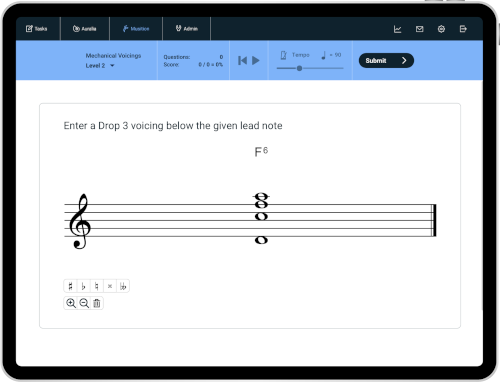Topics
Learn music theory the easy way
There are 61 topics in Musition®, divided into seven groups: Pitch, Rhythm, Terms & Symbols, Harmony & Instruments, General Knowledge and Composition.
Each topic has a series of carefully graded levels, allowing students of all abilities to comfortably use the software. Teachers can create custom levels to ensure curriculum support and appropriate assessment.
Pitch
Note Reading
Identify notes on a staff, or enter notes on a staff.
- Ledger lines & accidentals
- Lessons with notation & playback
- Treble & Bass clef
Scale Degrees
Recognise a key signature and then identify the scale degree that a given note is within the key.
- Single notes or melodies
- Terminology – numbers, names or solfege
- Major and minor keys, up to 7 accidentals
Enharmonic Notes
Identify enharmonic variations of notes.
Advanced Note Reading
Identify notes on a staff, or enter notes using the tenor and alto clef.
Intervals
Identify an interval that is shown on a staff, or enter an interval on a staff.
Transposition
Transposing by key or interval on the treble and bass clefs.
Jazz Scales
Identify a scale shown on screen, fix incorrect notes in the scale, or enter the scale on a staff.
Scale Home Keys
Relate a mode to it’s parent major or minor scale.
Scales
Identify a scale shown on screen, fix incorrect notes in the scale, or enter the scale on a staff.
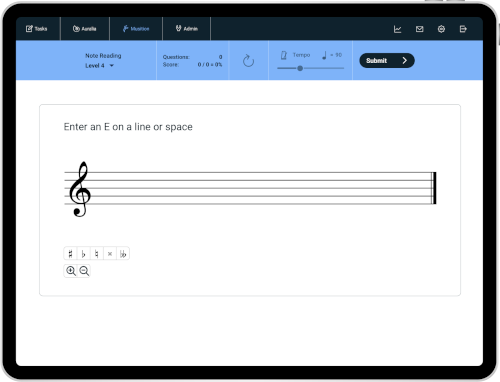
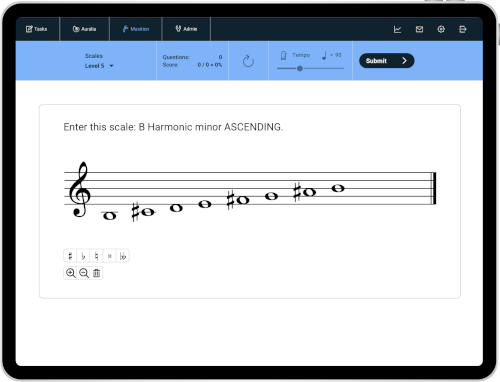
Melodic Motion
Define or identify melodic motion - similar. oblique, parallel or contrary.
Stem Direction
Identify the correct stem direction, using various positions on treble and bass clef.
Solfege Signing
Identify the displayed Solfege hand signs.
Rhythm
Beaming
A rhythm without beams is shown on screen, and you are asked to enter the correct beams.
- 2/4, 3/4, 4/4, 5/4, 6/8, 7/8 etc
- Length from 1 to 8 bars
- Notes & rests up to 32nd notes
Meter Recognition
Identify time signatures and their characteristics.
- Enter missing barlines
- Identify the meter
- Name the quality of the meter (simple duple etc)
- 2/4, 3/4, 4/4, 5/4, 6/8, 7/8 etc
Complete the Bar
Complete the bar with the correct number of notes or rests.
Rhythm Notation
Test your knowledge of note and rest values.
Ties
Rewrite extracts using ties, indicating rhythmic beats correctly.
Drum Sticking
Tap back a rhythmic pattern with your left and right hands.
Drum Styles
Tap back the rhythmic pattern shown on screen. The pattern is one part (eg: Snare Drum part) of a rhythmic style that would commonly be played on a drum kit.
Rhythm Tapping
Tap back the rhythmic pattern shown on screen. You may also tap the rhythm in using an external MIDI device such as a keyboard or wind controller, if connected.
Rhythmic Subdivision
Test your knowledge of note and rest values, and the concept of subdivision
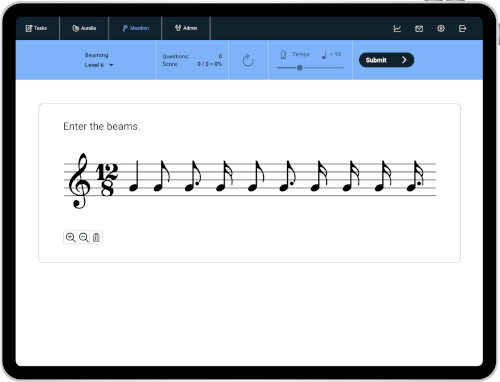
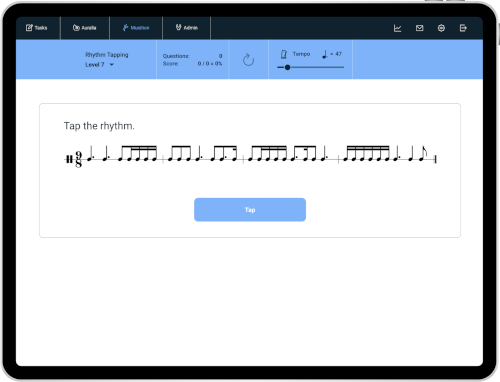
Rhythm Syllables
Identify syllables, add them to notated rhythms, using the Kodály method.
Rhythm Counting
Add counting to a displayed excerpt.
Meter Transposition
Test your knowledge of note and rest values, and the concept of subdivision
Polyrhythms
Practise tapping more complex rhythms, with one or two hands. Many common patterns such as 3 against 2 are included.
Terms & Symbols
Guitar Symbols
Identify the chord that is represented by the guitar symbol.
- Hundreds of symbols
- Custom levels
- Comprehensive lessons
Ornaments
Identify ornaments such as trills, acciaccatura, appoggiature etc.
- Identify the ornament
- Show how the ornament would be played
- Acciaccatura, Appoggiatura, Turns, Mordents etc
Concepts
Test your knowledge of common musical concepts, the fundamentals of written vocabulary. Questions are multiple choice.
Jazz Chord Symbols
Identify chord symbols, and the structure of the chord that they represent.
Symbols
Test your knowledge of common symbols that are found on scores. Questions are multiple choice.
Terms
Test your knowledge of common terms that are found on scores. Questions are multiple choice.
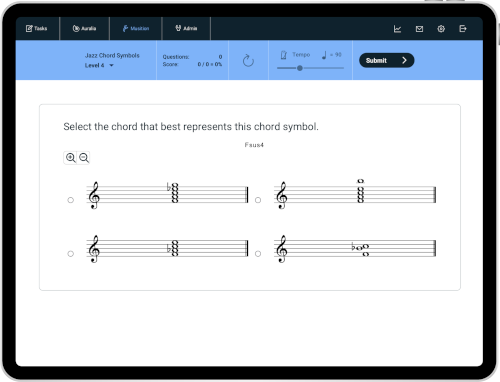
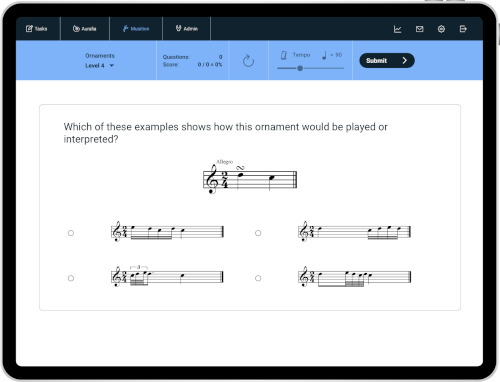
Harmony
Chords
Identify a chord that is shown on a staff, or enter a chord on a staff.
- Enter or identify chords on a staff
- Keys up to 7 sharps or flats
- Select from more than 50 included chords
- Add your own chords in the chord editor
Key Signatures
Assess your knowledge of keys, in particular, the number and type of accidentals that keys have and the order in which they appear on a staff.
- Enter and identify key signatures
- All keys up to 7 accidentals
- Relative major and relative minor
Cadences
Visually identify cadence types and the chords which form them.
Chord Progressions
In Chord Progressions, 4 part harmonic progressions are shown, and you are asked to identify the chords. You will need to identify the chord quality, as well as the position.
Diatonic Chords
Identify a chord that is shown on a staff, or enter a chord on a staff. The chords will be based on the scale degrees of the Major and Harmonic Minor scales.
Chromatic Chords
Enter chords on the staff, including applied dominants & applied diminished, augmented triads, mixture chords, neopolitan and augmented sixths.
Figured Bass
Realise given figured bass, enter chords notes on the staff. Includes all triads and sevenths, with inversions.
Jazz Chords
Identify a chord that is shown on a staff, or enter a chord on a staff.
Chord / Scale Relationships
Relate chords and scales, in a jazz context.
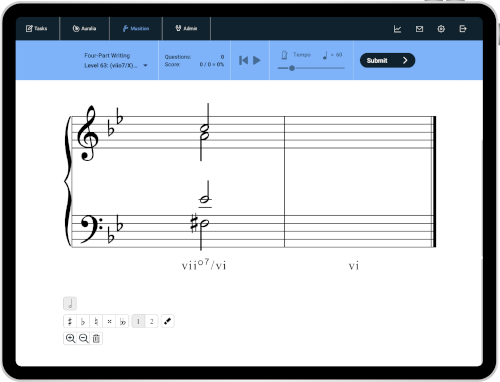
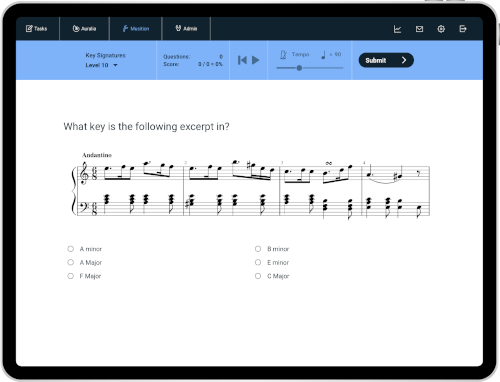
Advanced Chord Progressions
In Advanced Chord Progressions, 4 part harmonic progressions containing chromatic and mixture chords are shown, and you are asked to identify the chords. You will need to identify the chord quality, as well as the position.
Modulation
Identify the type of modulation (eg. Major Tonic – Relative Minor) or identify the final key of the example.
Nonharmonic Tones
Identify nonharmonic tones including passing, neighbour, incomplete neighbour, double neighbour, escape, anticipations etc.
Four-Part Writing
Complete the progression in four voices, following standard voice-leading rules.
Harmonization
Identify the chords that include the given scale degree.
Instruments
Clef Transposition
Transpose short melodies from one clef to another.
- Treble, Bass, Alto & Tenor clefs
- Ledger lines & accidentals
- Octave displacement
Range
Identify the range of various instruments.
- Comfortable and professional ranges
- All common instruments included
- Lessons with real instrument recordings
Keys
Identify the keys of various instruments, and identify the most ‘common’ key.
Piano Keyboard
Identify notes and enharmonic equivalents on the piano keyboard.
Knowledge
Test your general knowledge of instruments. Questions have multiple choice answers.
Recognition
Instrument examples are played (WAV files) and you have to identify the instrument from a number of choices.
Transposition
Transpose to and from concert pitch and the correct key for a particular instrument.

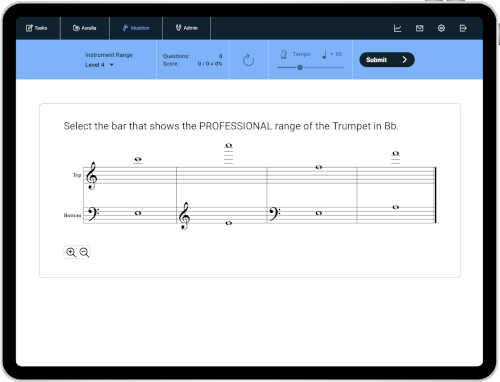
General Knowledge
Periods
Identify distinguishing features of the musical periods.
Composers
Identify the lifespan, birth country and musical period of various composers.
Texture & Density
Recognise the texture and changes in texture.
Phrase Structure & Form
Identify phrase structures and form including sentences, binary and ternary.
Pop Form
Identify the characteristics of various sections in popular music.
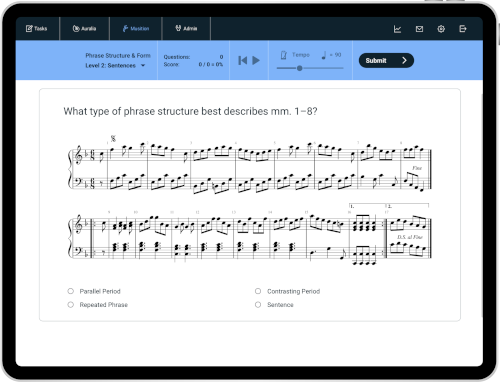
Composition
Compositional Devices
Identify compositional techniques.
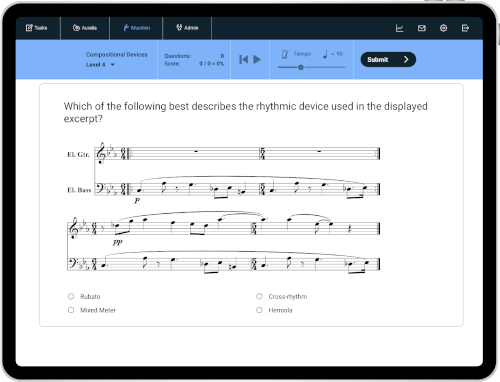
Mechanical Voicings
Enter mechanical voicings below a given lead note.
